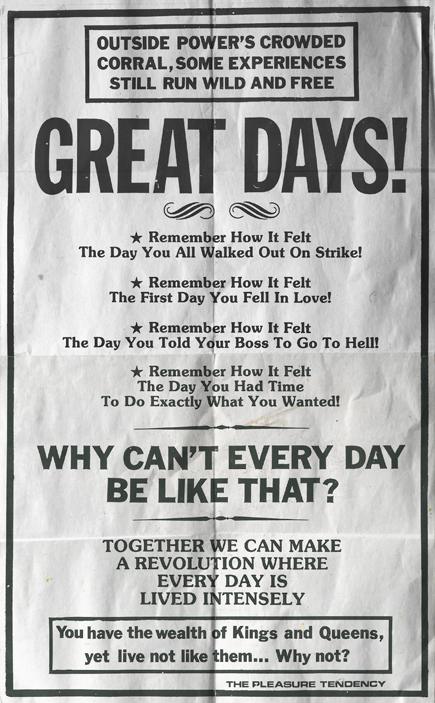What follows are some random (and rambling) thoughts on the power of events or acts to inspire whole movements – in part provoked by Paul Mason’s Twenty reasons why it’s kicking off everywhere, but also as an excuse to display this brilliant poster which I found at the bottom of a drawer the other day.
The events in north Africa sparked Paul Mason’s comments but obviously the question is a lot wider. How do isolated acts of resistance gel to become mass rebellions? And what conditions make them more likely to succeed (even if only for a short time)? The points that really interest me at the moment are points 3 and 7:
3. Therefore truth moves faster than lies, and propaganda becomes flammable.
7. Memes: “A meme acts as a unit for carrying cultural ideas symbols or practices, which can be transmitted from one mind to another through writing, speech, gestures, rituals or other imitable phenomena. Supporters of the concept regard memes as cultural analogues to genes, in that they self-replicate, mutate and respond to selective pressures.” (Wikipedia) – so what happens is that ideas arise, are very quickly “market tested” and either take off, bubble under, insinuate themselves or if they are deemed no good they disappear. Ideas self-replicate like genes. Prior to the internet this theory (see Richard Dawkins, 1976) seemed an over-statement but you can now clearly trace the evolution of memes.
This brilliant timeline gives a sense of the stuff that’s been kicking off across the world over the last few months. It’s easy to over-state the cohesion and power of these events. And there is a risk of neophilia, of uncritically celebrating the new: “the time for change is now” – as if real change was impossible at earlier points. The flipside to this is the apocalyptic undertone which says, more or less openly, that if we fail to resist the imposition of austerity now, we’ll be fucked for several generations to come. But all the same, it certainly feels like we might be on the cusp of a shift in social relations (the crazy before the new). And part of that feeling is to do with the accelerating pace of events: that truth (the unfolding of new social relations) is moving faster than lies (the ability of capital and the state to restrain or limit our desires).
In the 1980s security experts in the West used the idea of the domino effect to talk about social movements in Central Latin America. El Salvador, Nicaragua, Guatemala, Honduras… the US government feared that victory by “communist” (sic) forces would threaten its own strategic interests. But underlying the domino theory was the idea that outside agitators (in this case, Moscow- or Cuban-trained revolutionaries) were somehow responsible for the rise of popular national liberation movements (fast forward 30 years and Gaddafi has been coming out with the same sort of bullshit, blaming widespread revolt in Libya on al-Qaeda).
Thinking about the speed of change, a lot has been made of the role played by social networking tools (Twitter, Facebook etc etc), but the fact is that struggles have always circulated one way or another – the Black Jacobins didn’t rely on tweets from Paris, but news still went back and forth, albeit in a much slower way. Obviously, the speed at which information can be shared helps to build up momentum in a way that three-monthly dispatches can’t. And momentum appears to be key here. As recent events in north Africa and the Gulf states show, it is the idea of rebellion that spreads as much as the act itself – and it moves far faster than any outside agitator. It’s a contagion that doesn’t depend on physical contact. In fact, it makes more sense to think about this in terms of resonance.
But if we are thinking about social change in terms of memes, how do they arise? Perhaps one of the key assets of memes is that they are reproducible across a range of environments. In Egypt, Tunisia and Bahrain and elsewhere, for example, the occupation of public space, like Tahir Square and Pearl Roundabout, has been a central theme. There might be a connection here to simple acts of disobedience or resistance which are taken up and spread rapidly – like Rosa Parks’ refusal to move to the back of the bus, or the mass refusal of the Poll Tax. These acts tend to be low-cost entry points into a movement: people can ‘do’ them (and so join a ‘movement’) without actually doing a lot. To join the anti-Poll Tax movement, all people had to do was not pay something that many of us couldn’t afford to pay anyway. Those individual acts then became part of a much wider collective event. And in a world of atomised social relations, it is this collectivity that is crucial. It creates new possibilities, new worlds (perhaps, we could conjugate resistance in this way: I transgress, you resist, we world).
But numbers, on their own, are not enough. I lived down South during the 1984–85 miners’ strike and the bright yellow Coal Not Dole stickers were a great marker for where the lines had been drawn between Us and Them. But most of the time they were also accompanied by a sense of stalemate, of a pitched battle. There was rarely enough shift in Us to destabilise Them. Compare this to the anti-Poll Tax movement where the weeks and months leading up to Trafalgar Square seemed to be filled with an escalation of events as local town halls were occupied or surrounded as they set their taxes. There was a sense of movement. Perhaps numbers plus momentum equals a new collective body. And perhaps we can think of momentum as the rapid expansion and mutation of memes.
Again, it seems that the sense of moving is key to the way memes multiply and spread. The moment of greatest potential in this festival video is when dozens of people swoop in from all directions to join the dance. At that stage we have no idea what will happen: perhaps we’ll storm the stage; perhaps we’ll tear down the fence that separates the festival from the rest of the world; perhaps we’ll create a living sculpture. Who knows what this new collective body can achieve? And it’s hard not to feel a little deflated when the crowd turns toward the stage at the end and applaud the band and themselves: like establishing a Commune and then rushing to home to cheer a newly elected government.
Moreover, if this sense of momentum offers a real break from the everyday, it’s a break not just from the numbing routine of work-consume-sleep but also from the routine of work-politics-meeting-leaflet etc etc. The multiplication of acts of resistance and emergence of social movements also means a regroupment or re-alignment of our forces. The ‘activist fiction’ (the idea that the world will be changed by activists, therefore we need to make more activists) has become even more unsustainable in the face of recent events.
But why are some acts taken up, replicated and spread, while others remain entirely isolated? Why do we remember Rosa Parks and not Claudette Colvin? Is there some magic pixie-dust that will guarantee success? Clearly not. We have to gamble. And that means history will always be littered with discarded leaflets, dead campaigns, acts that didn’t take off. Our notion of what is possible is constrained by the ‘reality’ of everyday life. Sometimes it takes an act of imagination (of fiction, even) to reveal the real potential. And once we’ve glimpsed another world, it’s harder to go back.
Which also makes me think of this line from Pulp’s Glory Days:
Oh we were brought up on the Space-Race,
now they expect you to clean toilets.
When you’ve seen how big the world is,
how can you make do with this?


1 Comment